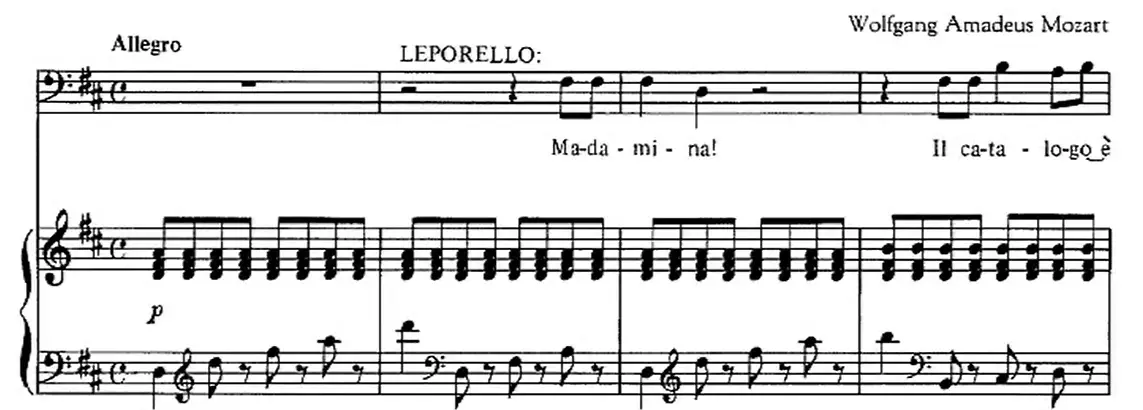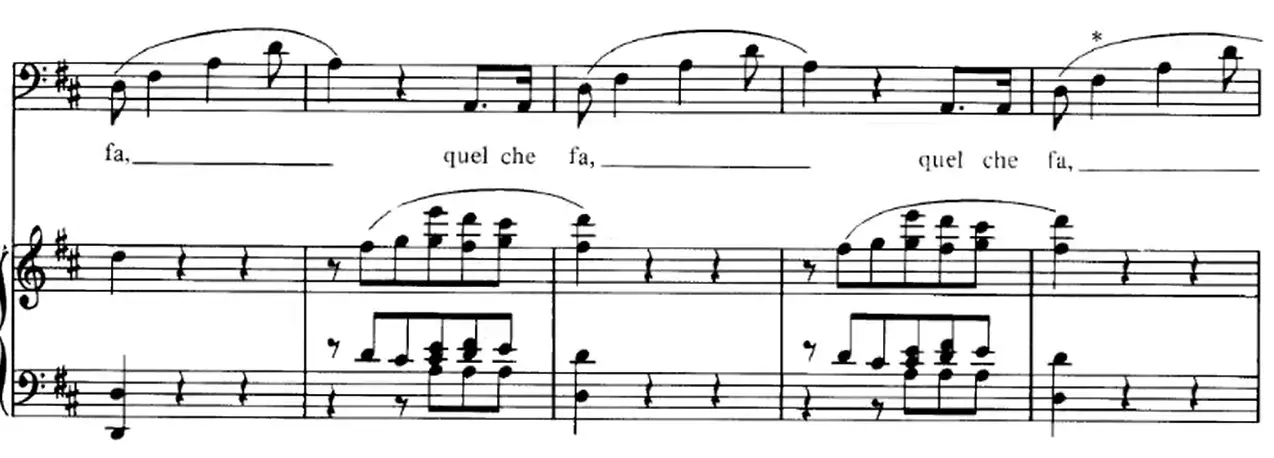the online opera guide to Mozart’s Aria MADAMINA, IL CATALOGO E QUESTO
Read Interesting facts and hear great YouTube Videos about the famous Aria “MADAMINA, IL CATALOGO E QUESTO”.
If you want to hear more about the opera Don Giovanni, click on the link to the opera portrait
The aria – synopsis & background
Synopsis: Leporello and Don Giovanni are on the road in Sevilla. Leporello accuses Don Giovanni of leading the life of a villain. Don Giovanni cuts him short because the next conquest is imminent. His unerring sense tells him that there is a woman nearby. Donna Elvira actually appears. She is a woman from Burgos who has been seduced and abandoned by Don Giovanni and is looking for him. Don Giovanni does not recognize her and speaks to the beautiful one. She recognizes him. After the jealous scene, Don Giovanni leaves the unfortunate and Leporello advises her to forget Don Giovanni because she will not be his first nor his last conquest. With pleasure he tells her that Don Giovanni already had over 2000 lovers and explains Don Giovanni’s conquest technique in detail.
The orchestra begins with a pulsating rhythm that awakens lust and comedy already in the first bars. As if it were the most natural thing in the world to keep a catalogue of his love affairs, Leporello busily begins his evil game:
He even asks Elvira to take a look at the catalogue “osservate, e leggete” (look and read). Accompanied by giggling flutes, he begins to read aloud from the catalogue. He begins with Italy:
In Italy, six hundred and forty;
In Germany, two hundred and thirty-one;
A hundred in France; in Turkey, ninety-one;
But in Spain already one thousand and three.
Altogether there are over 2000 conquests. His greatest success was in Spain. With two large fermatas, the four-digit number of conquests in Spain is highlighted. This first part is concluded with a quickly spoken passage and a forte end.
After the Allegro of the first part, Mozart changes the tempo to an Andante. In this second part of the aria, Leporello portrays the conquests with precision. Mozart lets big women have long notes, small women short notes.
Leporello is very nasty when he comes to the beginners (“la giovin principiante”, the young unexperienced), because Don Giovanni loves them most and probably Donna Elvira belonged to this group. The orchestra trills mischievously yet sarcastically when he sings this passage.
Leporello saves the biggest impudence for the end of this aria.
So long as she wears a skirt
You know what he does
He sings provocatively slowly 4 times “quell’ che fa” (what he does) and pokes around in the wound of poor Elvira:
Mozart and Da Ponte prove true black humour.
The aria – the text of MADAMINA, IL CATALOGO E QUESTO
Madamina, il catalogo è questo
Delle belle che amò il padron mio;
un catalogo egli è che ho fatt’io;
Osservate, leggete con me.In Italia seicento e quaranta;
In Almagna duecento e trentuna;
Cento in Francia, in Turchia novantuna;
Ma in Ispagna son già mille e tre.V’han fra queste contadine,
Cameriere, cittadine,
V’han contesse, baronesse,
Marchesine, principesse.E v’han donne d’ogni grado,
D’ogni forma, d’ogni età.
Nella bionda egli ha l’usanza
Di lodar la gentilezza,
Nella bruna la costanza,
Nella bianca la dolcezza.Vuol d’inverno la grassotta,
Vuol d’estate la magrotta;
È la grande maestosa,
La piccina e ognor vezzosa.Delle vecchie fa conquista
Pel piacer di porle in lista;
Sua passion predominante
È la giovin principiante.Non si picca – se sia ricca,
Se sia brutta, se sia bella;
Purché porti la gonnella,
Voi sapete quel che fa.
Young lady, this is the catalogue
Of the beautiful women loved by my masterIt is a catalogue I drafted myselfLook, read with me.In Italy, six hundred and forty;In Germany, two hundred and thirty-one;A hundred in France, ninety-one in Turkey;But in Spain, they’re already one thousand and three.Among these, peasantsMaids, city dwellersThere are countesses, baronessesMarchionesses, princess.There are women from every levelEvery shape, every age.His custom is to praiseThe blonde for her kindness,The brunette for her loyalty,The white for her sweetness.He wants a tubby woman in winterA slim woman in summer;[He says] tall women are majesticSmall women, always charming.He seduces old womenFor the pleasure of having them in his list;His main passionIs the young inexperienced.
He doesn’t care if she’s richIf she’s ugly, if she’s beautiful:As long as she wears a skirt,You know what he does…
Written for a buffo bass
The role of Leporello is written for a buffo bass. This bass has the acting abilities to play a comedic role. His voice should be flexible and must be able to bring voice colours and nuances to life. The singer must master text and music with ease in order to achieve the comedic effect without sacrificing musical performance.
Famous interpretations of MADAMINA, IL CATALOGO E QUESTO
A great interpretation by Feruccio Furlanetto and acting by Donna Elvira and Don Giovanni in this Metropolitan Opera recording. The facial expression alone is a pleasure.
Madamina, il catalogo è questo – Furlanetto
A recording of Giuseppe Taddei, perhaps the most renowned of all Leporellos. Here in the legendary Giulini recording from the fifties.
Madamina, il catalogo è questo – Taddei
Next, a recording of John Eliott Gardiner. It is a great pleasure to listen to the orchestra, where every detail is audible.
Madamina, il catalogo è questo – James / Gardiner
Erwin Schrott in an idiosyncratic production of the Salzburg Festival.
Madamina, il catalogo è questo – Schrott
To conclude you hear a movie version of Maazel’s production (making of). With an impressively long list…
Madamina, il catalogo è questo – van Dam
Peter Lutz, opera-inside, the online opera guide to the Aria “MADAMINA, IL CATALOGO E QUESTO” from the opera Don Giovanni.







dynamic